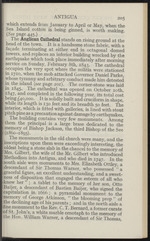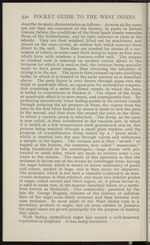| 1 |
 |
“...ANTIGUA 205
I which extends from January to April or May, when the
- Sea Island cotton' is being ginned, is worth making
; (See page 445.)
j The Anglican Cathedral stands on rising ground at the
head of the town. It is a handsome stone fabric, with a
I facade terminating at either end in octagonal domed
towers, and replaces an inferior building wrecked by the
I earthquake which took place immediately after morning
j service on Sunday, February 8th, 1843. The cathedral
I occupies the very spot where the militia were stationed
I m 1710, when the mob attacked Governor Daniel Parke
whose tyranny and arbitrary conduct made him detested
: in the island (see page 201). The corner-stone was laid
in 1845» The cathedral was opened on October 10th,
i 1847, and completed in the following year, its total cost
[hchig £40,000. It is solidly built and cruciform in shape,
while its length is 130 feet and its breadth 50 feet. Thé
interior, which is fitted with galleries, is lined with stout
pitch pine as...”
|
|
| 2 |
 |
“..." massecuite,”
being transferred to the centrifugals,—large drums with per-
forated or mésh sides, which axe made to revolve some 1,200
times to the minute. The result of this operation is that the
molasses is driven out of the drums by centrifugal force, leaving
the sugar behind, which is mixed to secure uniformity of grade
and colour, packed in bags, and is then ready for shipment.
The molasses, which is not such a valuable commodity as mus-
covado molasses, is then reboiled, and made into inferior grades
of sugar, called second and third sugars, or, if prices favour it,
is used to make rum, in the manner described below, or a cattle-
food known as Molascuit. This commodity, patented by the
late Mr. George Hughes, consists of the interior or cellulose
fibre of the sugar-cane finely screened and then blended with
cane molasses. In most parts of the West Indies rum is a
secondary product to sugar, but on some estates in Jamaica
the sugar-canes are grown principally for the purpose of making...”
|
|
